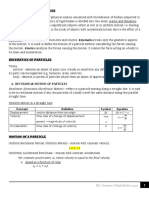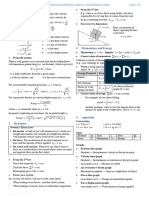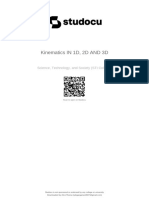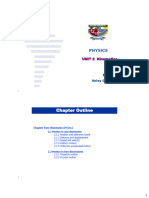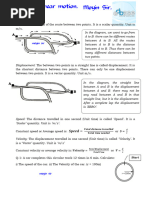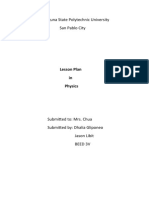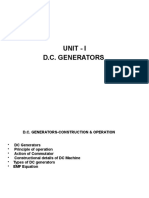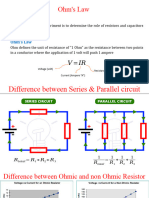Chapter 2-Kinematics
Chapter 2-Kinematics
Uploaded by
antonstefanbiehlerCopyright:
Available Formats
Chapter 2-Kinematics
Chapter 2-Kinematics
Uploaded by
antonstefanbiehlerOriginal Description:
Copyright
Available Formats
Share this document
Did you find this document useful?
Is this content inappropriate?
Copyright:
Available Formats
Chapter 2-Kinematics
Chapter 2-Kinematics
Uploaded by
antonstefanbiehlerCopyright:
Available Formats
Chapter 2
Kinematics
_____
Rectilinear Motion (1-D motion) Graphs: Definitions:
Remember to assign a reference positive direction and be constant throughout. Displacement: is the distance travelled in a stated direction from a reference
Waves
point. (Vector)
Types of Graphs Gradient represents Area Under Graph
Velocity: is the rate of change of displacement with respect to time. (Vector)
represents
Displacement – Time 𝑑𝑠 - Acceleration: is the rate of change of velocity with respect to time. (Vector)
𝑣𝑒𝑙𝑜𝑐𝑖𝑡𝑦 =
𝑑𝑡 Speed: is the rate of change of distance travelled with respect to time. (Scalar)
Velocity – Time 𝑑𝑣 Displacement
𝑎𝑐𝑐𝑒𝑙𝑒𝑟𝑎𝑡𝑖𝑜𝑛 =
𝑑𝑡 Equations of Motion: only apply for uniform acceleration in a straight line.
Acceleration - Time - Change in velocity
1) 𝑣 = 𝑢 + 𝑎𝑡
1 Derived using area under Velocity-
Motion of object falling in a uniform g-field with air resistance: 2) 𝑠 = 𝑢𝑡 + 𝑎𝑡 2 Time graph and Equation (1)
2
Time Forces acting on object Motion of object
3) 𝑣 2 = 𝑢2 + 2𝑎𝑠 Derived using Equation (1) and (2)
𝒕 = 𝟎𝒔 Initial velocity is zero
Above equations are used in a uniform gravitational field without air resistance.
Only force acting on object is its
weight
Projectile Motion (Non-linear motion):
𝑨𝒄𝒄𝒆𝒍𝒆𝒓𝒂𝒕𝒊𝒐𝒏 = 𝒈
Horizontal Motion: Vertical Motion:
Velocity constant, Acceleration is 0 Acceleration is constant
𝒕 = 𝒕𝟏 As object velocity increases, the
drag force (due to air resistance
increases from zero.
𝐹𝑛𝑒𝑡 = 𝑚𝑔 − 𝐹𝐷
𝑨𝒄𝒄𝒆𝒍𝒆𝒓𝒂𝒕𝒊𝒐𝒏 < 𝒈
𝒕 = 𝒕𝟐 When 𝐹𝐷 = 𝑚𝑔, resultant force on
object is zero.
𝑨𝒄𝒄𝒆𝒍𝒆𝒓𝒂𝒕𝒊𝒐𝒏 = 𝟎
Object falls with max. constant
velocity, called Terminal Velocity
Superphysics.sg
You might also like
- Learnfast Review and Tutorial Hub - Nmat Reviewer: Velocity, Acceleration, Force Work50% (2)Learnfast Review and Tutorial Hub - Nmat Reviewer: Velocity, Acceleration, Force Work8 pages
- Motion Common Test Reference Sheet PDF VersionNo ratings yetMotion Common Test Reference Sheet PDF Version1 page
- Docsity Physics 1 Notes Basic Physics ConceptsNo ratings yetDocsity Physics 1 Notes Basic Physics Concepts2 pages
- Kinematics: Two and Three Dimensional Motion: Intended Learning Outcomes (Ilo)No ratings yetKinematics: Two and Three Dimensional Motion: Intended Learning Outcomes (Ilo)4 pages
- Mechyr1 Chapter 9::: Constant AccelerationNo ratings yetMechyr1 Chapter 9::: Constant Acceleration22 pages
- Chapter 2. Motion Along A Straight Line: Lecture 3. Displacement, Time, VelocityNo ratings yetChapter 2. Motion Along A Straight Line: Lecture 3. Displacement, Time, Velocity6 pages
- Significant Figures: Scalar and Vector QuantitiesNo ratings yetSignificant Figures: Scalar and Vector Quantities6 pages
- 4 Cube Notes Projectile Motion & Circular Motion PDF FileNo ratings yet4 Cube Notes Projectile Motion & Circular Motion PDF File6 pages
- CE Board April 2023 - Engineering Mechanics - Set 5No ratings yetCE Board April 2023 - Engineering Mechanics - Set 54 pages
- 10SCI - 2 - Forces and Motion - Revision Notes - ALLKNo ratings yet10SCI - 2 - Forces and Motion - Revision Notes - ALLK2 pages
- Classical Mechanics and Biomechanics (I) : Biophysics RamosNo ratings yetClassical Mechanics and Biomechanics (I) : Biophysics Ramos6 pages
- Subtopic: 2.1 Linear Motion 2.2 Uniformly Accelerated Motion 2.3 Projectile MotionNo ratings yetSubtopic: 2.1 Linear Motion 2.2 Uniformly Accelerated Motion 2.3 Projectile Motion26 pages
- Fluid Mechanics 2nd Edition by Russell Hibbeler – Solutions for ExercisesNo ratings yetFluid Mechanics 2nd Edition by Russell Hibbeler – Solutions for Exercises40 pages
- Laboratory No. 3 - Application of Ohms Law in DC Parallel CircuitNo ratings yetLaboratory No. 3 - Application of Ohms Law in DC Parallel Circuit5 pages
- Physics 06-01 Temperature and Thermal ExpansionNo ratings yetPhysics 06-01 Temperature and Thermal Expansion2 pages
- Answers & Solutions: For For For For ForNo ratings yetAnswers & Solutions: For For For For For22 pages
- Datasheet Tensite Batteries Opzs 6v 600ahNo ratings yetDatasheet Tensite Batteries Opzs 6v 600ah3 pages
- Basic Lab Question 2021 For Group B Final 2No ratings yetBasic Lab Question 2021 For Group B Final 215 pages






